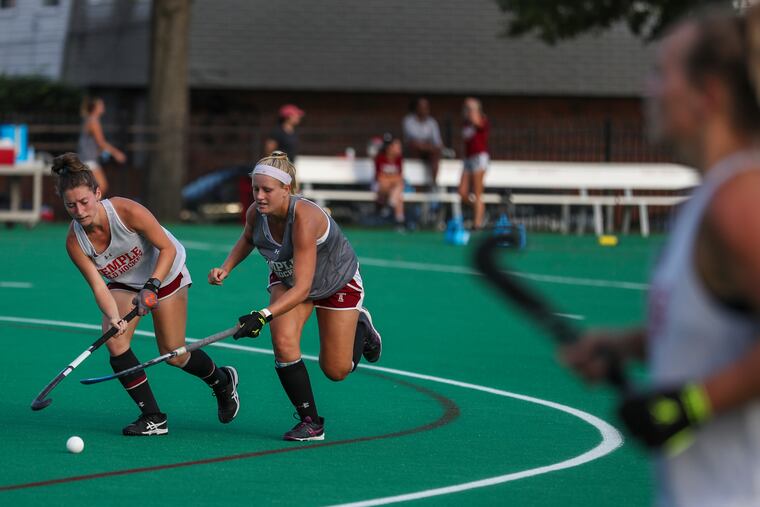NCAA needs a massive new travel plan for most of its sports | Mike Jensen
The plan: Stop putting so many teams on so many planes. Most D-I schools simply won’t be able to afford the travel that’s been done lately. So don’t make them do it. Don’t let them do it.

Everyone working in college sports seems to agree on this: Finances going forward are going to be tricky at best. Hard decisions will be made across the board, all levels.
Here’s an idea that could save money, across the board, at least in Division I.
Stop putting so many teams on so many planes.
There needs to be a massive plan, from the highest levels of the NCAA, that would basically scrap the current leagues for nonrevenue sports.
Most D-I schools simply won’t be able to afford the travel that’s been done lately. So don’t make them do it. Don’t let them do it.
Why, for instance, should St. Joseph’s and La Salle still send teams to St. Louis when that can cost up to $20,000 per trip? Same for Temple taking teams to Dallas and Houston.
This is an opportunity to restore some fiscal sanity in college sports, while maybe keeping some of these teams from going away completely.
Why not mandate, for instance, that nonrevenue teams can only make two regular-season plane trips a year? That means they could go to Florida or anywhere else for a week; but otherwise, if you can’t get there on a bus, you can’t go. Maybe a limit on overnight trips, too.
Maybe the Power 5 conferences wouldn’t go along. Fine, exempt them. Get them out of the equation. Just don’t let them call the shots for the rest of the schools hemorrhaging money, fighting for survival.
You could say that football and men’s and women’s basketball could continue on, but everybody else, stay close to home. (Or include them in this, too -- although TV is going to want a say in this.)
Take an example from the Philadelphia Soccer Seven, where the locals all play each other, with standings and award winners.
Let’s say the Ivy League keeps its own thing going, since that’s mostly bus trips already.
But for others, in baseball and softball, field hockey and lacrosse, put together leagues actually based on geography.
Around here, that’s pretty easy. The City 6 schools, plus Delaware and Delaware State, Lehigh and Lafayette and Rider. You’ve got a good schedule going already.
Rowing already kind of does this, with East Coast schools regularly gathering at the Schuylkill or at Princeton, Boston, or Worcester, Mass.
Good examples abound in Division II and III. A great example is the realignment that resulted in the CACC south division. You might have to Google what CACC stands for (Central Atlantic Collegiate Conference, duh), but it’s a fine local Division II league, with Jefferson, Holy Family, Sciences, Chestnut Hill, Wilmington, Goldey-Beacom, and Georgian Court in one compact outfit.
Examples also exist all over Division I. Leagues are allowed to take in what you might call orphan schools, ones that offer a sport that isn’t played in their primary league. For instance, Big East women’s lacrosse includes Old Dominion and Denver. Big East field hockey includes only three full-time members among its eight schools. (Connecticut field hockey was ahead of the curve, already in the league before the rest of its teams join this year. Other Big East field hockey teams include Temple, Old Dominion, Liberty, and Quinnipiac, joining Villanova, Providence, and Georgetown.
So what has to happen, the idea of only competing in the league you’re usually in has to change. For Philly D-I schools, nonleague games against all the schools within a bus ride brings New England down to Virginia into play. Maybe that’s not as easy in other regions of the country. But most places have plenty of schools to fill schedules. Deal with the ones that don’t but start with the ones that do.
We looked at this spring’s abbreviated St. Joe’s baseball schedule. The Hawks started the 2020 season with four February games in Florida. Could still do that. Then there were three more games in South Carolina. Makes sense, given the weather issue. Maybe make that five games. Then there were more games after that in North Carolina, and back to Florida. Those might have to go.
Once home, the Hawks were supposed to play three games against Long Island University. That would still be kosher. Then a Villanova game. (Make it two.) Then league play was to begin with three games at home against Rhode Island. (Sure, still works.) One against Bucknell. (Yep, play it.)
Then, three A-10 games at St. Louis. (Nope, that’s got to go.) Another trip was to be to Davidson, N.C. (A tweener, up for debate.)
You get the point. Go back to the days of the old ECAC, where East Coast schedules could be drawn up allowing for closer games. Rivalries could be rekindled, a win-win, unless you care about that big St. Joe’s-St. Louis rivalry.
If this level of sanity had been applied in recent decades, it might have saved some sports that already hit the chopping block. (Yes, we’re looking at you, Temple.)
Would coaches and players love this whole idea? Yes, we’d argue, if it meant the difference between saving a sport and cutting it, they would love it a whole lot.
None of it would be easy to figure out. It’s just 100% worth figuring out.